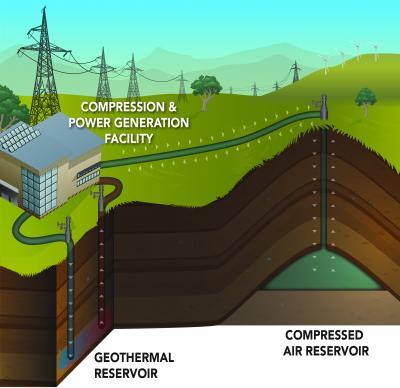forum
library
tutorial
contact

Researchers Look Underground and
Find a Promising Energy Storage Option
by Elizabeth Harball
E & E, May 28, 2013
|
the film forum library tutorial contact |

|
Researchers Look Underground and
by Elizabeth Harball
|
 In the late springtime, weather conditions in the Pacific Northwest
are a little too perfect for renewable energy generation.
In the late springtime, weather conditions in the Pacific Northwest
are a little too perfect for renewable energy generation.
According to Peter McGrail of the Pacific Northwest National Laboratory (PNNL), a Department of Energy research institution, spring runoff from the mountains overwhelms the region's hydroelectric system. Additionally, spring is when wind velocities are at their highest, creating a surplus of energy from the region's wind farms.
"It's also the time of year when electrical demand is usually relatively low," McGrail added. "We have way too much generation capacity taking place when load is quite low, so there's an imbalance in supply and demand."
To solve this problem, a new federal study indicates it is possible to preserve significant amounts of the Northwest's excess wind energy by storing it underground in the form of compressed air.
The Bonneville Power Administration (BPA), a federal power marketing agency based in Portland, Ore., worked with PNNL scientists to study the potential of compressed-air energy storage in the Northwest. In the end, two economically viable sites were identified with a combined storage capacity of about 380 megawatts -- enough to power about 85,000 homes each month, according to PNNL.
If constructed, these facilities would be the first compressed-air energy storage plants to use natural basalt deposits as reservoirs, representing a unique solution to the supply-demand imbalance that often plagues renewable energy projects.
Quick growth spurs need for storage
Oregon and Washington are now two of the top states in total overall wind power generation, ranking fourth and sixth, respectively, according to the American Wind Energy Association.
Washington's government has required the state's large utilities to get 15 percent of their electricity from renewable sources by 2020. Oregon's renewable portfolio standard obligates utilities to source 25 percent of their electricity from renewables by 2025.
"We have already seen here in the Northwest some of the greatest penetration of renewables over the last few years," said Steven Knudsun, who oversaw the BPA/PNNL report. "It's been an increasing challenge to balance all those renewables.
"It was actually the very successful development of renewable generation in the Northwest ... that caused us to start looking for new and innovative ways of integrating those resources," he added.
Compressed-air energy storage could allow the Northwest's wind energy providers more flexibility regarding when and how much electricity is meted out to the grid.
Excess wind energy, normally dumped before it overloads the grid, would be used to power compressors that pump air into deep geological reservoirs, found more than 1,500 feet underground. When this energy is needed, the air is brought back to the surface, expanding back to normal atmospheric pressure and spinning a turbine that drives a generator to turn it back into electricity.
At the one compressed-air energy storage plant currently operating in the United States, located in McIntosh, Ala., the air is held in a man-made underground salt cavern. However, these formations are not common in the Pacific Northwest, so the PNNL/BPA researchers turned to the 81,000 square miles of continental flood basalt deposits beneath Washington, Oregon and Idaho.
The basalt deposits are extremely porous, Knudson explained, and compressed air could move quickly in and out of the reservoirs to support the swift cycling needed to balance the day-to-day energy production of a wind farm.
A zero-emissions possibility

One of the proposed plants, the Yakima Minerals Site near Selah, Wash., represents another new development in compressed energy storage.
When air is forced to go from a high-pressure environment to a low- pressure environment, it becomes very cold in what physicists call the Joule-Thomson effect.
"We have to actually provide some heat back into the system so that the air doesn't get so cold that it actually would become liquid," McGrail said.
With conventional air energy storage sites, as with the other proposed plant near Boardman, Ore., natural gas is used to heat the system. But natural gas was not available for the Yakima Minerals Site, so the researchers have proposed the use of geothermal heat, making it a zero-emissions plant.
If the Yakima Minerals Plant is constructed, it would produce power at a cost of 11.8 cents per kilowatt-hour. Power produced at the Oregon plant, called the Columbia Hills Site, would cost about 6.4 cents per kWh. The current average cost of residential electricity in Washington is 8.5 cents per kWh.
Moreover, the cost of constructing a compressed-air energy storage plant would be roughly equal to the cost of building a conventional natural-gas-fired plant, Knudsun said.
"The Northwest does have geology that can support this type of facility," Knudson said, "not only to make it work, but actually make it work in a cost-effective and a competitive manner with other storage technologies."
But more regulations need to be put in place before the proposed projects are attractive options for the region's local utilities or developers.
"One of the biggest obstacles right now is regulatory support for a market mechanism to allow this type of facility or storage asset to be developed and actually be able to market services," Knudson said. "We do not have organized markets in the Northwest like in many other parts of the country ... so there's not a clear path for a developer of this type of asset to be able to recover their costs by selling the products and services into the markets."
He added, "It's going to be important for the regulators to create a path forward for this type of asset to become commercially successful in its development."
learn more on topics covered in the film
see the video
read the script
learn the songs
discussion forum
